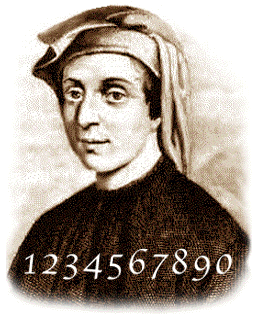...Best of Sicily presents... Best of Sicily Magazine. ... Dedicated to Sicilian art, culture, history, people, places and all things Sicilian. |
by Carlo Trabia | ||
Magazine Index Best of Sicily Arts & Culture Fashion Food & Wine History & Society About Us Travel Faqs Contact Map of Sicily |
The numerals were known in Europe since at least the tenth century, but as recently as the fifteenth their use was viewed as arcane. Evidence suggests that the first European region to use Arabic numerals as the official system was Sicily. This coincides with Arab rule in the tenth century. From India the "Arabic" numerals had made their way west over the course of centuries. But when did use of the numerals in Sicily become truly commonplace? Qaid Brun (born Thomas Le Brun), a treasurer to the king of Sicily by 1154, used Arabic numerals and then took the numeration system to the English court, where it was not immediately embraced. Later, at the court of Frederick II in Palermo, a Pisan mathematician later known as Leonardo Fibonacci (died 1250), shown here, advocated use of Arabic numerals based not only on his observations in Sicily but around the Arab Mediterranean world. In 1202 he completed his manuscript Liber Abaci about Arabic numerals and their use in calculations. It was "modern" printing (with movable type) that made the new mathematical numeration popular, some three centuries after Fibonacci's visit to Sicily. Apart from convenient decimal (base ten) computation, which made use of zero as a digit and concept, the Arabic system brought about popular adoption of ideas we now take for granted. As Arabic is written and read right to left, this originally applied to the numerals as well as the alphabet. Roman numerals are written left to right, with the highest value on the left; applying this principle to the Arabic numerals in a European context reversed the way they were sequenced in Arabic-speaking lands. Eventually the world followed the new Eurocentric trend. The Middle Ages and the Renaissance brought to the fore a number of gifted mathematicians and scientists, but developments such as Arabic numerals (properly "Hindu-Arabic" numerals) were late to reach Europe beyond Sicily and Spain. Today it's difficult to imagine life without them. About the Author: Architect Carlo Trabia has written for this publication and others. | |
Top of Page |
 The
wide use of Arabic numerals represented a landmark in mathematical development.
The glyphs (symbols) used may be distinguished from the decimal system represented.
The numbers trace their origin to India circa 400 BC (BCE). This is not
to say that all the digits we know today were known during that period.
The use of zero, the most "recent" glyph, appears to have begun
only in the ninth century.
The
wide use of Arabic numerals represented a landmark in mathematical development.
The glyphs (symbols) used may be distinguished from the decimal system represented.
The numbers trace their origin to India circa 400 BC (BCE). This is not
to say that all the digits we know today were known during that period.
The use of zero, the most "recent" glyph, appears to have begun
only in the ninth century.